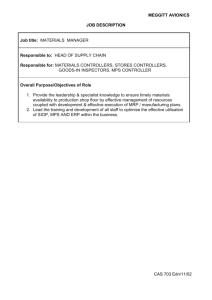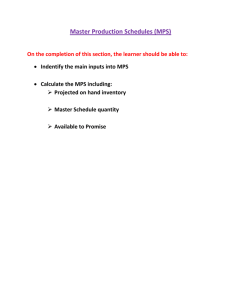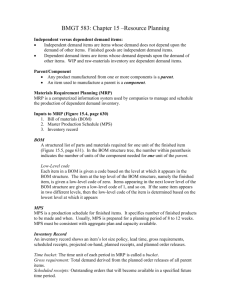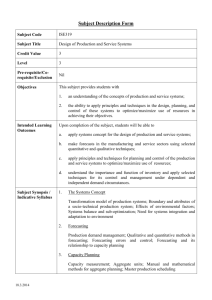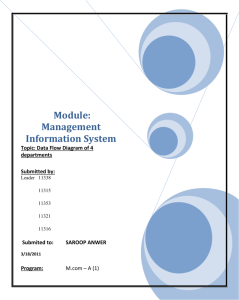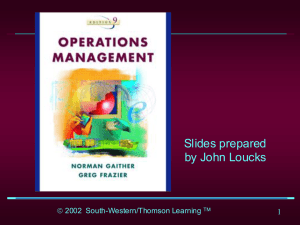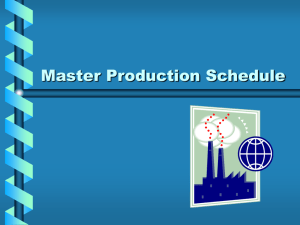IEEM 3041
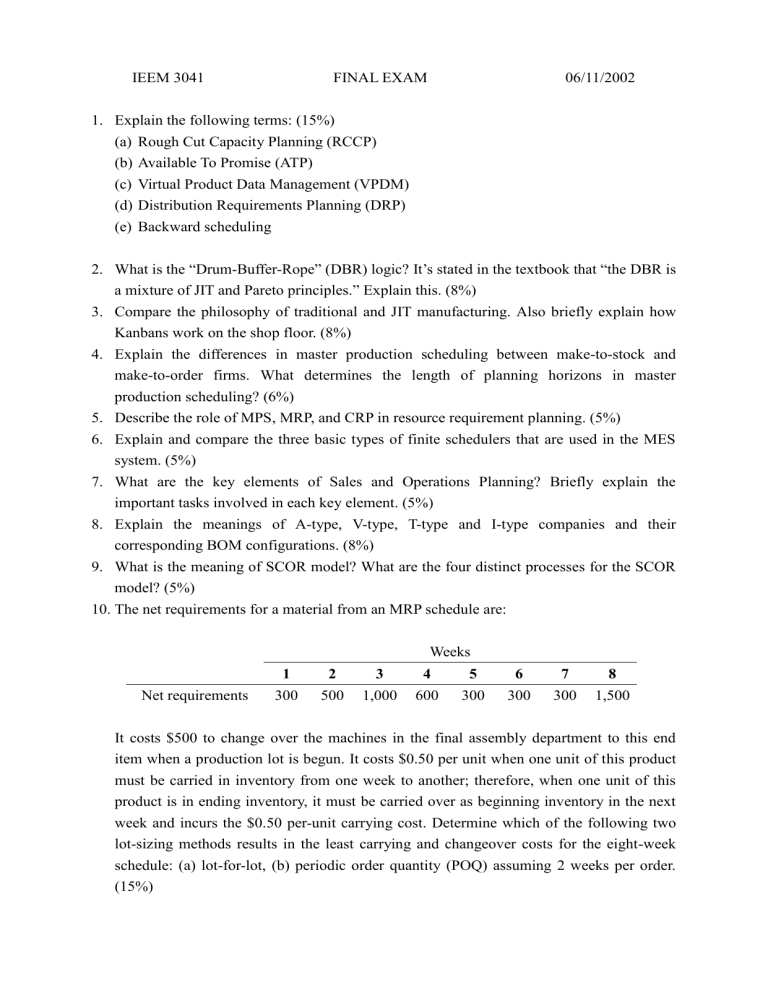
IEEM 3041 FINAL EXAM 06/11/2002
1.
Explain the following terms: (15%)
(a) Rough Cut Capacity Planning (RCCP)
(b) Available To Promise (ATP)
(c) Virtual Product Data Management (VPDM)
(d) Distribution Requirements Planning (DRP)
(e) Backward scheduling
2.
What is the “Drum-Buffer-Rope” (DBR) logic? It’s stated in the textbook that “the DBR is a mixture of JIT and Pareto principles.” Explain this. (8%)
3.
Compare the philosophy of traditional and JIT manufacturing. Also briefly explain how
Kanbans work on the shop floor. (8%)
4.
Explain the differences in master production scheduling between make-to-stock and make-to-order firms. What determines the length of planning horizons in master production scheduling? (6%)
5.
Describe the role of MPS, MRP, and CRP in resource requirement planning. (5%)
6.
Explain and compare the three basic types of finite schedulers that are used in the MES system. (5%)
7.
What are the key elements of Sales and Operations Planning? Briefly explain the important tasks involved in each key element. (5%)
8.
Explain the meanings of A-type, V-type, T-type and I-type companies and their corresponding BOM configurations. (8%)
9.
What is the meaning of SCOR model? What are the four distinct processes for the SCOR model? (5%)
10.
The net requirements for a material from an MRP schedule are:
Weeks
1 2 3 4 5 6 7 8
Net requirements 300 500 1,000 600 300 300 300 1,500
It costs $500 to change over the machines in the final assembly department to this end item when a production lot is begun. It costs $0.50 per unit when one unit of this product must be carried in inventory from one week to another; therefore, when one unit of this product is in ending inventory, it must be carried over as beginning inventory in the next week and incurs the $0.50 per-unit carrying cost. Determine which of the following two lot-sizing methods results in the least carrying and changeover costs for the eight-week schedule: (a) lot-for-lot, (b) periodic order quantity (POQ) assuming 2 weeks per order.
(15%)
【 Hint 】
Week Costs
1 2 3 4 5 6 7 8 carrying ordering Total
Net requirements
Beginning inventory
Production lots
Ending inventory
11. A company manufactures bar code scanners on a produce-to-order basis. The company manufactures three models of the scanners on the same final assembly line. The final assembly has 20,000 hours of weekly capacity. The six-week MPS and the final assembly standard for each model are: (15%)
Product
Final Assembly
Standard
(hours per scanner) 1
Weekly Production (scanners)
2 3 4 5 6
A
B
C
25
30
35
200 150 200 250 150 250
100 200 350 250 150 250
150 150 150 200 250 250
(a) Compute the actual final assembly hours required at the plant in each week and for the total six weeks to produce the MPS (this is often referred to as load). Compare the load to the labor-hours capacity in each week and for the total six weeks.
(b) Does enough production capacity exist to produce the MPS.
(c) What changes to the MPS would you recommend?
12. Apply Johnson’s rule to schedule the following jobs such that the makespan can be minimized. (10%)
Job Number Processing time on the first machine
A
B
C
D
E
4
16
8
12
3
Processing time on the second machine
5
14
7
11
9



